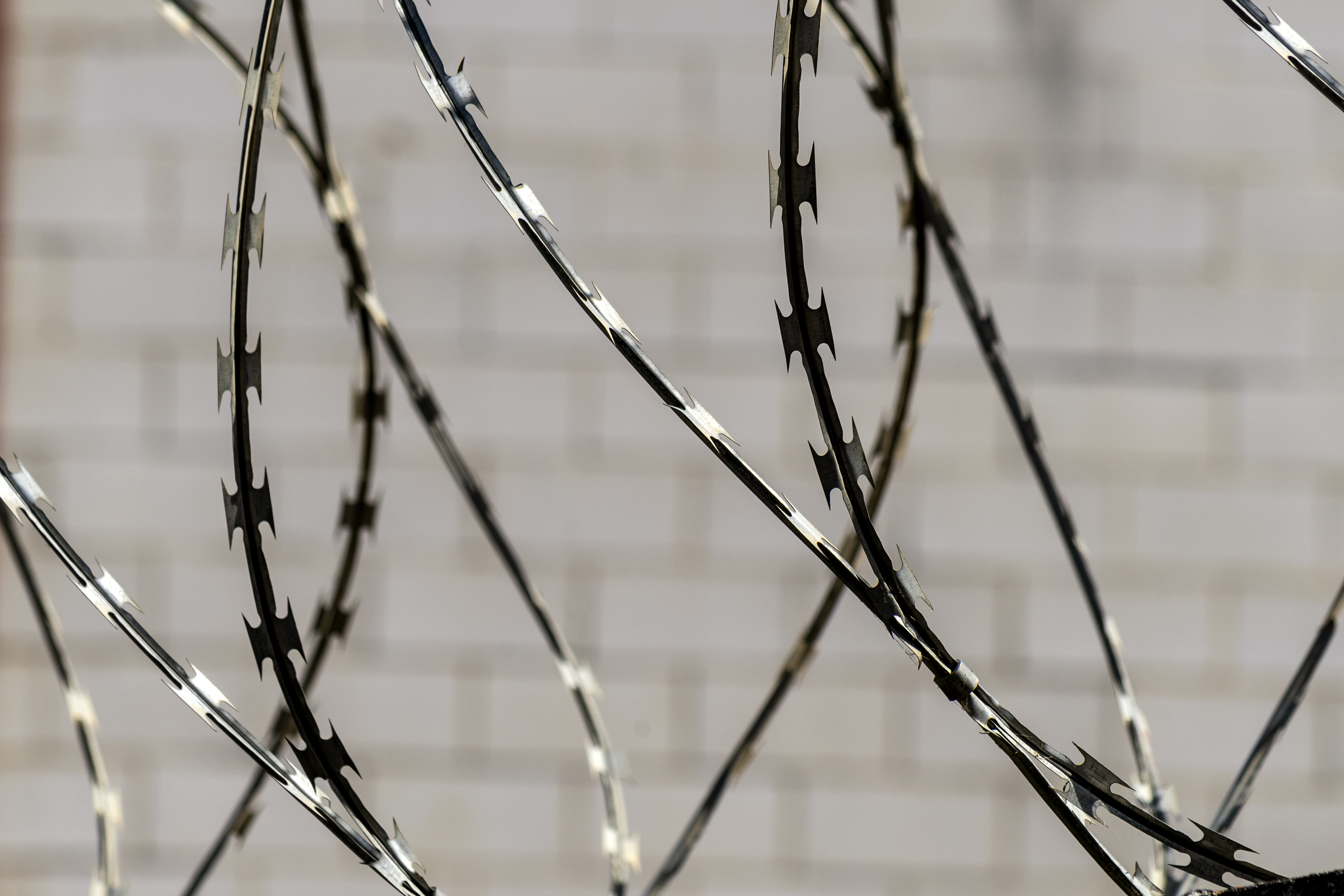SCOTUS Rules for Biden Admin. in Texas Border Wire Case
The Supreme Court this week issued a terse order vacating an injunction imposed by the Fifth Circuit in DHS v. Texas — a case brought by the state of Texas to stop Biden’s CBP from destroying portions of a 29-mile section of concertina-wire (“c-wire”) barriers erected by the state along the Rio Grande in Maverick County to deter illegal migrants. Two of the Court’s conservatives — Chief Justice John Roberts and Justice Amy Coney Barrett — joined the three liberal justices in that decision, but their order hardly settles the matter. In fact, given the unresolved factual and legal issues in this case, it’s really just begun.
Operation Lone Star. In March 2021, Texas Gov. Greg Abbott (R) launched “Operation Lone Star”, a state initiative to supplement CBP’s efforts to respond to the massive wave of migrants who began pouring across the river after Joe Biden took office and quickly reversed his predecessor’s controversial — but successful — border deterrence policies.
As the governor explained at the time:
The crisis at our southern border continues to escalate because of Biden Administration policies that refuse to secure the border and invite illegal immigration. … Texas supports legal immigration but will not be an accomplice to the open border policies that cause, rather than prevent, a humanitarian crisis in our state and endanger the lives of Texans. We will surge the resources and law enforcement personnel needed to confront this crisis.
Under Lone Star, state troopers from the Texas Department of Public Safety (DPS) and National Guard troops from the state’s Military Department (TMD) were deployed to the border to monitor incursions and, in the case of the troopers, pursue and interdict human- and drug-smugglers and migrants.
Once they apprehended those smugglers, migrants, and drugs, the troopers would call Border Patrol to come and pick everyone and everything up. Sometimes agents responded quickly, but other times they were too overwhelmed processing illegal entrants to appear in a timely manner.
DPS also charges those smugglers and migrants with state-law violations, such as trespassing on private land and drug trafficking and/or possession, as appropriate. I note that Texas recently passed a law broadening that authority by making illegal entry into the state across the international boundary a crime, but that law is not set to take effect until March (the administration’s challenging that law, too).
The C-Wire Barrier and CBP’s Unusual Response in Maverick County. Texas expanded Lone Star in the lead-up to the termination of Title 42 on May 11. To dissuade migrants who were expected to cross the border once those public-health orders expired, DPS and TMD began installing c-wire barriers on the Texas side of the river.
As the Fifth Circuit noted in its most recent order in this case:
The c-wire serves as a “deterrent — an effective one at that,” causing illegal crossings to drop precipitously. “By all accounts, Border Patrol is grateful for the assistance of Texas law enforcement, and the evidence shows the parties (Texas and CBP] work cooperatively across the state, including in El Paso and the Rio Grande Valley.”
Notably omitted by the circuit court there was any mention of that fencing along 29 miles of the Rio Grande in Maverick County, where the barrier has not been so warmly received by Biden’s CBP of late.
For reasons that still remain unclear, the agency began cutting and tearing out portions of that c-wire fence there starting in September, to allow migrants to enter illegally and putatively go to a nearby CBP processing facility.
In response to that action, Texas filed a complaint in the U.S. District Court for the Western District of Texas, where it was assigned to Judge Alia Moses. That complaint asked the court to enjoin DHS “from seizing and destroying [its] concertina wire fencing and maintaining breaches in said fencing”.
As I explained shortly thereafter, the state offered six separate legal arguments for the relief it sought, two of which were premised on the hoary common law torts of “conversion” and “trespass to chattels”, respectively.
Those were novel arguments from my experience, not because they’re not valid, but because the federal government rarely goes around randomly trashing state property, at least not with advance notice and some explanation.
In any event, Judge Moses granted the state a temporary restraining order (TRO) in late October to halt that destruction of the c-wire barrier until she could sort it all out.
“A Harmful Mixture of Political Rancor and Ego”. On November 29, however, Judge Moses issued an Opinion and Order denying Texas’ request for a preliminary injunction. That may have been a victory for the administration, but her order was far from a glowing endorsement of its actions.
On the legal front, she found the state’s tort claims were barred under the principle of “sovereign immunity”, under which the “sovereign” — in this case the United States — must consent to any suit against it. That meant that the state could seek monetary damages for what CBP was doing to its fencing, but Texas wasn’t seeking money — it wanted its fencing left alone.
That said, the state also alleged claims under the Administrative Procedure Act (APA) — which governs executive-branch rulemaking and agency actions — and the APA does clearly waive federal immunity.
Specifically, Texas alleged that “federal agents have developed and implemented a policy, pattern, or practice of destroying Texas’s concertina wire to encourage and assist thousands of aliens to illegally cross the Rio Grande and enter” the state since September 20, and that this was a “final agency action” challengeable under the APA.
The court rejected this claim at that stage but did not find that the state could not ultimately prove its argument. DOJ had admitted that there could be millions of pages of documents in its possession that reference Texas’s c-wire, but because the case had moved quickly, discovery was limited.
The state also alleged that CBP had “no colorable basis” for its actions, and therefore such actions were “ultra vires” because they exceeded the agency’s legal authority. Again, Judge Moses concluded that based on the scant record before her, the state had not proven this point sufficiently to justify entry of a preliminary injunction to stop destruction of the state’s concertina wire, but left that door open, too.
Which brings me to the district court’s scathing factual assessment of what’s really happening on the ground. Even before she began her legal analysis of the case, Judge Moses explained:
The U.S.-Mexico border presents a unique challenge that is equal parts puzzling to outsiders and frustrating to locals. The immigration system at the heart of it all, dysfunctional and flawed as it is, would work if properly implemented. Instead, the status quo is a harmful mixture of political rancor, ego, and economic and geopolitical realities that serves no one. So destructive is its nature that the nation cannot help but be transfixed by, but simultaneously unable to correct, the present condition. What follows here is but another chapter in this unfolding tragedy. The law may be on the side of the Defendants and compel a resolution in their favor today, but it does not excuse their culpable and duplicitous conduct. [Emphasis added.]
The “culpable and duplicitous conduct” in question was the federal government’s contentions that its destruction of the state’s c-wire was essential to CBP carrying out its statutory duties to apprehend, inspect, and detain aliens who have entered illegally.
As she explained, DHS:
cannot justify cutting or moving the [state’s] fence whenever and wherever they find convenient based on a supposed need to access the river by both boat and foot so they may passively observe migrants crossing. Nor can they do so when the [DHS fails] to direct migrants attempting to unlawfully enter the United States to return back across the border per longstanding, Supreme Court-sanctioned practice.
Moreover, evidence in the case revealed that once aliens were allowed through the fence, CBP directed them to a “further-inland processing center” about a mile away “with vanishingly little if any further supervision or direction” — a route bordered by a separate state fence.
In fact, Texas offered evidence showing that more than 40 percent of the aliens who crossed never actually present themselves for processing thereafter. The court noted:
No unfair cynicism is required to suspect that some such migrants likely commit other crimes (e.g., drug smuggling, human trafficking, etc.) during this process, providing ample incentive for the individuals posing the greatest public danger to flee rather than deliver themselves to [DHS]. [Emphasis added.]
The Fifth Circuit. Texas quickly filed an appeal with the Fifth Circuit, which on December 4 granted an administrative stay of Judge Moses’ order. Next, on December 19, the circuit panel issued a published order, finding that the district court had erred on the question of sovereign immunity, and enjoining DHS from destroying the c-wire fence while it considered the state’s appeal.
Contrary to the legal conclusions below, the circuit court held that the APA “plainly” waived the federal government’s immunity for the common-law tort claim of trespass to chattels, and concluded that it therefore did not have to consider the state’s remaining APA claims — which remain at issue.
Finding that the state would be “irreparably harmed” absent a stay, it barred DHS from cutting the wire pending appeal. For good measure, the panel included pictures of Border Patrol agents pulling back the barrier and allowing illegal migrants to pass through.
Enter the Solicitor General. As if to prove Judge Moses’ point about “a harmful mixture of political rancor [and] ego … that serves no one”, on January 2, Elizabeth Prelogar — solicitor general (SG) of the United States and DOJ’s top courtroom lawyer — filed an application with the U.S. Supreme Court to vacate the circuit court’s injunction pending appeal.
She argued therein that under the Constitution’s supremacy clause, “state law cannot be applied to restrain … federal agents from carrying out their federally authorized activities” and that the circuit court had turned that principle on its head “by requiring federal law to yield to Texas law”.
Texas filed its response a week later, noting that the Fifth Circuit had already agreed to hear its appeal in this case on February 7, and arguing therefore that there was no “extraordinary” reason that would justify the Court intervening at this point.
The state further argued that vacation of that injunction was inappropriate because it was likely to succeed on its claims (including the APA claims that the circuit court had not considered) and that in any event, the justices were unlikely to fully consider the “narrow, fact-bound dispute” in this case on certiorari.
The legal niceties quickly spun out of control thereafter on January 10, when the state seized a city-owned facility in Eagle Pass (the county seat of Maverick County) called Shelby Park — directly adjacent to the river — and TMD began installing new fencing around it.
That prompted Prelogar to file a supplemental memorandum with the Court on January 12, contending that the new “fencing further restricts Border Patrol’s ability to reach the river in particular areas”, including — critically it would turn out — a boat ramp in the park.
The next day, the state filed its response, arguing that the SG’s memorandum “reflects a lack of on-the-ground understanding of what is happening in Maverick County”, particularly the fact that:
Border Patrol previously used the complex of municipal recreational facilities known collectively as “Shelby Park” to facilitate the daily entry of thousands of these individuals who chose not to enter at the lawful port of entry. … But for several weeks, it is the case that large groups of people no longer cross at Shelby Park — and [DHS], in any event, abandoned the area months ago. [Citations omitted; emphasis in original.]
Importantly, attached to that response was a declaration from the TMD colonel with responsibility over that department’s operations in south Texas generally and Eagle Pass in particular. He explained:
On January 11, 2024, after CBP was informed by TMD of their intention to take control of Shelby Park, several CBP boats were witnessed conducting operations in the river unimpeded. Yet, the next day, January 12, 2024, CBP appeared to have ceased watercraft patrols. This appears to have been a voluntary choice on CBP’s part that occurred following their filing in this Court.
That statement is important because it has largely been overlooked in light of an unfortunate, but much-discussed, incident that occurred on the night of January 12 — the day before that declaration was filed, when a migrant female and two children drowned in the Rio Grande near the park.
Initially, as CBS News reported, “federal officials claimed that National Guard soldiers deployed by Republican Texas Gov. Greg Abbott did not allow Border Patrol agents to attempt to rescue the migrants”.
In her second supplemental memorandum filed with the Supreme Court on January 15, however, Prelogar explained that Mexican officials had only informed CBP that those individuals had drowned an hour after the fact (at 8:00 PM that night), at the same time those Mexican officials “advised Border Patrol of two migrants in distress on the U.S. side of the river in the area near the Shelby Park boat ramp”.
The SG claimed in her memorandum that the acting Border Patrol supervisor on duty then went to the entrance gate at Shelby Park to tell the National Guard troops there about the drowned migrants and the two migrants in distress, but that Border Patrol agents were nonetheless denied entry to the park.
In its January 17 response, the state disputed those assertions:
Texas has conducted a diligent investigation into these allegations that refutes Defendants’ dire accusation. Based on that investigation, the two Border Patrol agents who approached the gate on January 12 did not ask for admission to Shelby Park to respond to an emergency, nor did they advise either the Guardsmen or the Staff Sergeant that any “emergency” situation existed. … Far from it: The Border Patrol agents advised that Mexican authorities had already responded to drownings on the other side of the international border an hour earlier and that Mexican officials had the situation under control.
In fact, Mexican officials did rescue the two individuals, but that raises two questions that are yet unanswered: (1) did CBP stop operating boats in the area of Shelby Park on the day those migrants drowned; and (2) how close were those migrants to Shelby Park when they drowned?
The Court’s January 22 Order. As noted, on January 22 the Court issued a brief order in Texas:
The application to vacate injunction presented to Justice Alito and by him referred to the Court is granted. The December 19, 2023 order of the United States Court of Appeals for the Fifth Circuit … is vacated.
Justice Thomas, Justice Alito, Justice Gorsuch, and Justice Kavanaugh would deny the application to vacate injunction.
That means that this was a 5-4 decision, with Justices Robert and Barrett joining Justices Kagan, Sotomayor, and Jackson in vacating the Fifth Circuit’s injunction. As noted, this case involves some unique legal issues about the interplay between state tort law and the supremacy clause, so it could have gone either way.
In response, Texas state Attorney General Ken Paxton issued a statement describing the Court’s order as “temporary”, and asserting: “The destruction of Texas’s border barriers will not help enforce the law or keep American citizens safe. This fight is not over, and I look forward to defending our state’s sovereignty.”
The January 12 drowning incident — the facts of which are still unresolved — may have tipped the balance in favor of the Court’s order, but in the justices’ defense, they usually don’t have to consider, let alone resolve, such factual disputes.
Neither do circuit-court judges, but expect those issues to be relitigated during the February 7 oral arguments in Texas. This case is far from over, but until it is, expect the state of Texas to splash pictures of Biden’s CBP cutting its concertina-wire fence to usher illegal migrants into the United States everywhere.






